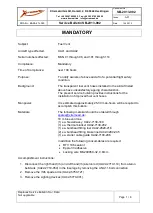
SECTION 3
CESSNA
EMERGENCY PROCEDURES
MODEL 172RG
5.
Mixture -- IDLE CUT-OFF.
6.
Cranking -- CONTINUE.
7.
Fire Extinguisher - - OBTAIN (have ground attendants obtain if not
installed).
8.
Engine -- SECURE.
a.
Master Switch -- OFF.
b.
Ignition Switch -- OFF.
c.
Fuel Selector Valve -- OFF.
9.
Fire - - EXTINGUISH using fire extinguisher, wool blanket, or dirt.
10.
Fire Damage -- INSPECT, repair damage or replace damaged
components or wiring before conducting another flight.
ENGINE FIRE IN FLIGHT
1.
Mixture -- IDLE CUT-OFF.
2.
Fuel Selector Valve -- OFF.
3.
Master Switch -- OFF.
4.
Cabin Heat and Air -- OFF (except overhead vents).
5.
Airspeed -- 105 KIAS (If fire is not extinguished, increase glide
speed to find an airspeed which will provide an incombustible
mixture).
6.
Forced Landing -- EXECUTE (as described in Emergency Landing
Without Engine Power).
ELECTRICAL FIRE IN FLIGHT
1.
Master Switch -- OFF.
2.
Avionics Power Switch -- OFF.
3.
All Other Switches (except ignition switch) -- OFF.
4.
Vents/Cabin Air/Heat -- CLOSED.
5.
Fire Extinguisher -- ACTIVATE (if available).
W
ARNING
After discharging an extinguisher within a closed cabin,
ventilate the cabin.
If fire appears out and electrical power is necessary for continuance of
flight:
6.
Master Switch -- ON.
7.
Circuit Breakers -- CHECK for faulty circuit, do not reset.
8.
Radio Switches -- OFF.
9.
Avionics Power Switch -- ON.
10.
Radio/Electrical Switches -- ON one at a time, with delay after
each until short circuit is localized.
3-6
1 July 1979
CESSNA
SECTION 3
MODEL 172RG
EMERGENCY PROCEDURES
11.
Vents/ Cabin Air/Heat -- OPEN when it is ascertained that fire is
completely extinguished.
CABIN FIRE
1.
Master Switch -- OFF.
2.
Vents/Cabin Air/Heat -- CLOSED (to avoid drafts).
3.
Fire Extinguisher -- ACTIVATE (if available).
WARNING
After discharging an extinguisher within a closed cabin,
ventilate the cabin.
4.
Land the airplane as soon as possible to inspect for damage.
WING FIRE
1.
Navigation Light Switch -- OFF.
2.
Strobe Light Switch (if installed) -- OFF.
3.
Pitot Heat Switch (if installed) -- OFF.
NOTE
Perform a sideslip to keep the flames away from the fuel
tank and cabin, and land as soon as possible using flaps
only as required for final approach and touchdown.
I CING
INADVERTENT ICING ENCOUNTER
1.
Turn pitot heat switch ON (if installed).
2.
Turn back or change altitude to obtain an outside air temperature
that is less conducive to icing.
3.
Pull cabin heat and cabin air controls full out and open defroster
valves to obtain maximum defroster airflow.
4.
Increase engine speed to minimize ice build-up on propeller
blades.
5.
Watch for signs of carburetor air filter ice and apply carburetor
heat as required. An unexplained loss in manifold pressure could
be caused by carburetor ice or air intake filter ice. Lean the mixture
if carburetor heat is used continuously.
1 July 1979
3-7














































